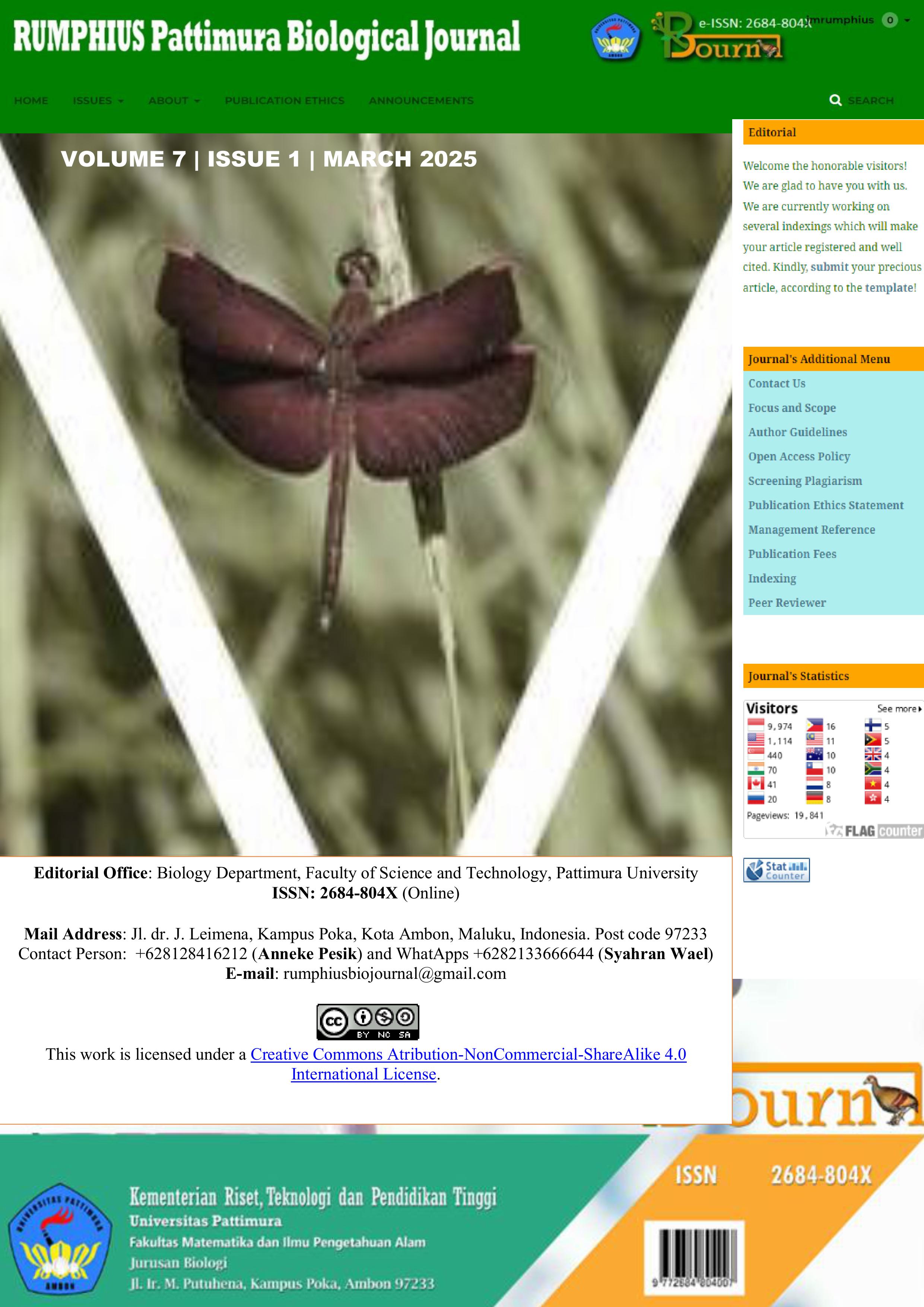Snake Species and Their Habitat Preferences on Marsegu Island, West Seram, Maluku, Indonesia
Abstract
Maluku, an archipelagic region, has unique ecological features that support a high level of biodiversity. One such island in this region is Marsegu Island, located in the Western Seram Regency, which is recognised as a nature reserve and serves as a natural habitat for several species of snakes. This study identifies snake species and analyses habitat preferences on Marsegu Island. Data were collected using the Visual Encounter Survey (VES) method. A total of six snake species from four families were recorded, with Colubridae being the most dominant. Species showed distinct habitat preferences: Xenopeltis unicolor was often found under decaying wood in mangrove areas, while Ahaetulla prasina was associated with Cerbera manghas trees. Larger species, such as Malayopython reticulatus, were found in coral rubble, while Cerberus schneiderii preferred semi-aquatic habitats in mangrove mud. The results suggest that the distribution of snakes on Marsegu Island is strongly influenced by morphological and behavioral adaptations to specific habitat types. This study provides new ecological insights into snake species in mangrove ecosystems and highlights the critical role of habitat conservation in maintaining biodiversity on Marsegu Island.
Downloads
References
Crump, M. L., & Scott, N. J, Jr. (1994). Visual encounter survey. In: W. R. Heyer, M. A. Donnelly, R. W. McDiarmid, A. C. Hayek, L.C & M. S. Foster (Eds), Measuring and monitoring Biological diversity, Standard Methods for Amphibians (pp. 84-91). Washington D. C: Smithsonian Institution Press
Das, I. (2015). A field guide to the reptiles of South-East Asia. London: Bloomsbury Publishing.
De Rooij, N. (1917). The reptiles of the Indo-Australian archipelago. Volume II: Ophidia. Leiden: E.J. Brill
De Lang, R., & Vogel, G. (2005). Snakes of Sulawesi: A field guide to the land snakes of Sulawesi with identification key. Frankfurt: Edition Chimaira
Fitch, H. S. (1999). A Kansas snake community: Composition and changes over 50 years. Florida: Krieger Publishing Company
Giri, C., Ochieng, E., Tieszen, L. L., Zhu, Z., Singh, A., Loveland, T., Masek, J., & Duke, N. (2011). Status and distribution of mangrove forests of the world using Earth observation satellite data, Global Ecology and Biogeography 20(1), 154–159. https://doi.org/10.1111/j.1466-8238.2010.00584.x
Greene, H. W. (1997). Snakes: The evolution of mystery in nature. California: University of California Press
Halliday, T. (2016). The book of frogs: A life-size guide to six hundred species from around the world. Berkeley: Chicago: University of Chicago Press
Indonesian Geospatial Information Agency. (2022). Gazetteer of the Republic of Indonesia: Topographic features of islands (1st ed.). Bogor: Geospatial Information Agency
Irwanto. (2017). Ekologi Pulau Marsegu Seram Bagian Barat. Ambon: Pattimura University Press
Iskandar, D. T., & Colijn, E. (2002). Checklist of Southeast Asian and New Guinean reptiles. I. Snakes. Biodiversity Conservation Project BCP 2000, Japan International Cooperation Agency (JICA), Institut Teknologi Bandung (ITB), & The Gibbon Foundation
Iskandar, D. T., & Erdelen, W. R. (2006). Conservation of amphibians and reptiles in Indonesia: Issues and problems, Amphibian and Reptile Conservation 4(1), 60–87.
Kurniawan, N., Fathoni, M., Fatchiyah, F., Aulanni’am, A., Septiadi, L., & Smith, E. N. (2021). Composition, distribution, and habitat type of snakes in Java, with discussion on the impact of human-snake interactions during 2013–2019, Herpetology Notes 14, 691–711.
Luiselli, L. (2006). Resource partitioning and interspecific competition in snakes: The search for general geographical and guild patterns, Oikos 114(2), 193–211. https://doi.org/10.1111/j.2006.0030-1299.14064.x
Mattison, C. (2014). Nature guide: Snakes, other reptiles, and amphibians. London: DK Publishing
McKay, J. L. (2006). Field guide to the amphibians and reptiles of Java and Bali. Florida: Krieger Publishing Company
Meiri, S., Feldman, A., & Kratochvíl, L. (2015). Squamate hatchling size and the evolutionary causes of negative offspring size allometry, Journal of Evolutionary Biology 28(4), 802–810. https://doi.org/10.1111/jeb.12580
Murphy, J. C. (2007). Homolopsid snakes: Evolution in the mud. Florida: Krieger Publishing Company
Murphy, J. C., Voris, H. K., & Karns, D. R. (2012). The dog-faced water snake, a revision of the genus Cerberus Cuvier (Squamata, Serpentes, Homalopsidae) with the description of a new species, Zootaxa 3484, 1–34
Pizzatto, L., Marques, O. A. V., & Martins, M. (2007). Ecomorphology of boine snakes, with emphasis on South American forms. In R. W. Henderson & R. Powell (Eds.), Biology of the boas and pythons (pp. 35–48). Eagle Mountain, UT: Eagle Mountain Publishing
Reed, R. N., & Rodda, G. H. (2009). Giant constrictors: Biological and management profiles and an establishment risk assessment for nine large species of pythons, anacondas, and the boa constrictor. U.S. Geological Survey Open-File Report 2009–1202.
Septiadi, L., Fathoni, M., Hanifa, B. F., & Hamidy, A. (2019). Morphological variation of Malaopython reticulatus (Schneider, 1801) from several populations in Indonesia, Journal of Tropical Life Science 9(3), 259–266. http://dx.doi.org/10.11594/jtls.09.03.07
Shine, R. (1991). Australian snakes: A natural history. Ithaca: Cornell University Press.
Shine, R., Harlow, P. S., Keogh, J. S., & Boeadi. (1998). The influence of sex and body size on food habits of a giant tropical snake, Python reticulatus, Functional Ecology 12(2), 248–258. https://doi.org/10.1046/j.1365-2435.1998.00179.x
Vitt, L. J., & Caldwell, J. P. (2014). Herpetology: An introductory biology of amphibians and reptiles (4th ed.). San Diego: Academic Press
Wallach, V., Williams, K. L., & Boundy, J. (2014). Snakes of the world: A catalogue of living and extinct species. Boca Raton: CRC Press
Wanger, T. C., Saro, A., Iskandar, D. T., Brook, B. W., & Sodhi, N. S. (2010). Conservation value of cacao agroforestry for amphibians and reptiles in Southeast Asia: Combining ecological, life-history, and socio-economic factors, Biological Conservation 143(4), 1060–1068. https://doi.org/10.1111/j.1365-2664.2009.01663.x
Whittaker, R. J., & Fernández-Palacios, J. M. (2021). Island biogeography: Ecology, evolution, and conservation (2nd ed.). Oxford: Oxford University Press
Zakaria, N., Allahudin, M. I. H., Ma’ad, S. N. S., Sulaiman, A. A., Abdullah, N. A., Zamri, M. I. M., Mamat, M. A., & Deraman, M. Y. (2022). Diversity of amphibians and reptiles at Sungai Kerteh mangrove forest, Terengganu, Malaysia, Biodiversity 23(11), 5574–5584. https://doi.org/10.13057/biodiv/d231105
Copyright (c) 2025 Christmas Saamangun, La Eddy, Handy Erwin Pier Leimena

This work is licensed under a Creative Commons Attribution-NonCommercial-ShareAlike 4.0 International License.
Authors who propose a manuscript and have it approved for publication know that the manuscript will be registered and become part of the RPBJ. Authors and readers understand that this journal is open and all its contents can be accessed freely, provided that RPBJ is still listed as the source of information. The hope is that this journal can become a vehicle for exchange and scientific knowledge for society and the scientific community, especially in the field of Biology and other branches of science.









